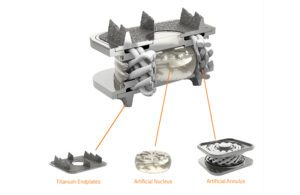
Orthofix Medical (Nasdaq:OFIX) today announced positive five-year data from the single-level IDE study of its M6-C artificial cervical disc.
Lewisville, Texas–based Orthofix will hold a presentation of the data on June 3 at the International Society for the Advancement of Spine Surgery annual meeting in Nassau, Bahamas.
It’s been more than three years since FDA approved the M6-C for the treatment of cervical disc degeneration. Since 2006, Orthifix has had more than 60,000 of its M6-C discs implanted in over 20 countries.
“We are pleased to see that at five years postoperative, participants in the study who received the M6-C artificial cervical disc continue to show significant benefits in Neck Disability Index (NDI) scores and neck and shoulder/arm pain Visual Analog Scale (VAS) scores compared to patients who received anterior cervical discectomy and fusion (ACDF),” said Dr. Frank Phillips, professor of orthopedic surgery at Rush University Medical Center and an investigator in the study.
“Additionally, M6-C patients in the study had a low rate of revision surgery compared to the ACDF cohort,” added Phillips, who will present the data at the ISASS meeting.
The IDE study’s five-year results included:
- At five years, patients receiving the M6-C disc experienced a mean NDI improvement from the baseline of 47.5 points, significantly better than the 33.4 for the ACDF cohort.
- Statistically significant favorable results were observed in shoulder/arm pain VAS scores at five years, with a mean of 0.5 for M6-C disc study patients and 2.1 for ACDF participants. There was a mean improvement from baseline of 6.8 for M6-C disc patients compared to 5.2 for the ACDF group.
- The M6-C disc’s subsequent surgical interventions (SSI) rate at five years was 3.1%, which Orthofix says is one of the lowest compared to other FDA-approved artificial cervical discs.
- There were five SSIs for M6-C patients in the study through five years post-op. Of the removals, two were performed due to persistent neck and arm pain (with one being replaced by a new M6-C disc,) and one was performed due to bone loss associated with a confirmed infection. In the ACDF cohort, 11 patients underwent SSIs.
Monitoring of the patients in the study will continue out to 10 years post-op.